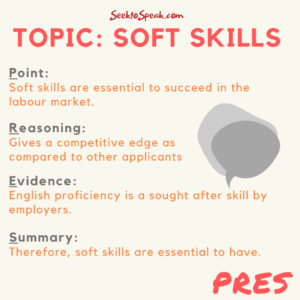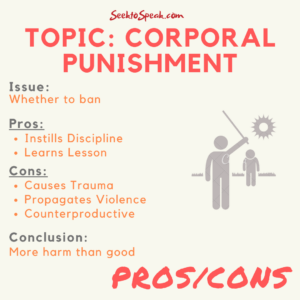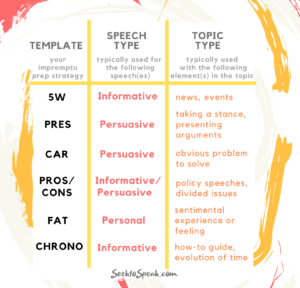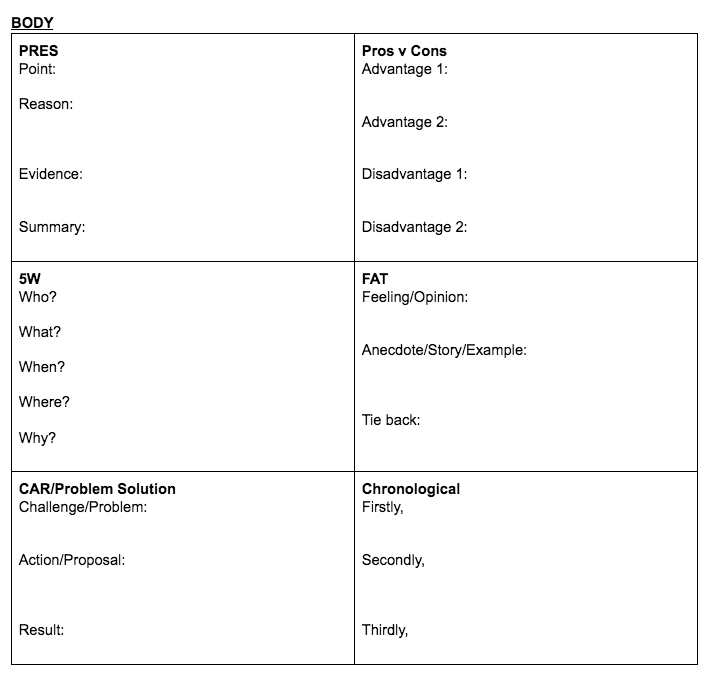Having to improvise is always daunting, even in a non-speaking context. Maybe you’re on holiday, and your tour fell through, necessitating a quick alternative plan. Perhaps you’re cooking dinner for friends, and you ran out of gas, forcing you to reevaluate the menu. Doing anything impromptu is HARD.
Therefore, practicing impromptu speeches not only hones your speaking skills but teaches you how to think quickly and adapt accordingly. Two things usually happen when prepping for impromptu speeches. Best case scenario, you experience a mind bomb, where your brain is a mess of ideas, your mind working overtime in panic. Worst case scenario, you experience the dreaded mind block, where your brain becomes blank, your mind freezing-up in anxiety.
Using Templates to Think & Speak Better
In dealing with this issue, I have found that speech templates help guide speakers to think in a structured and constructive manner. Templates help speakers navigate through the multitude of ideas plaguing your brain and the uncertainty of which angle to take. Templates also help speakers trigger ideas and points, pulling them out of a blank mind.
Below are my go-to speaking templates when it comes to improvising. Always remember that these templates are a guide only as there is no one-size-fits-all pattern to any topic. I actively encourage speakers to use multiple templates for a given topic and only later pick the best one.
Speech Template 1 – 5W
Who? What? When? Where? Why?
5W is the most simple speech template, asking and answering the most basic of questions, in no particular order, surrounding a topic. Who was involved? What happened? When did it happen? Where did it happen? Why did it happen? The 5W strategy is an excellent way to structure your impromptu speech if you intend to be informative rather than persuasive. Therefore, this is especially great for news or events that need explaining.
Example***

***Please see the first installment of this series on note-taking. Notes on improvised speeches should be concise and straight to the point.
Speech Template 2 – PRES
Point, Reasoning, Evidence, Summary
This the most common template if you have many ideas, arguments, or points regarding your topic. This method also ensures you have enough supporting reasons and examples to prove your point.
Start with encapsulating your Point into an easily digestible sentence. Then work on the premises of your point, highlighting the Reasons why you say so. After that, you provide the audience with sufficient Evidence to support your view. Evidence can come in the form of observations, personal experience, anecdotes, or facts. Lastly, conclude your point by Summarising your argument and reiterating your point.

Speech Template 3 – CAR
Challenge, Action, Result
CAR is the best template to use when the topic involves an obvious problem or issue that needs addressing/remedying.
Firstly, explain the Challenge faced, describing the need to do something. Secondly, propose a course of Action to take, explaining how such actions should be taken. Thirdly, emphasize the Result of the action, emphasizing the positive consequences of the action.

Speech Template 4 – Pros & Cons
Issue, Advantages, Disadvantages, Conclusion
This template starts by framing an Issue with broadly divided views. The speaker then moves on to talking about the benefits of Advantages of the issue, topic, or policy. After that, the speaker will talk about the drawbacks or Disadvantages of the same. Pros & Cons is an excellent template to use for topics that are pretty split, with plenty of views on either side. This template is also a common method to gauge the efficacy of a policy. Should a speaker wish to be persuasive, one side should outweigh the other, and the Conclusion would need to take a stand. Should the speaker want to be informative, equal amounts of advantages and disadvantages would suffice with the conclusion summarising the balanced views of the speaker.

Speech Template 5 – FAT
Feeling, Anecdote, Tie-back
This is probably the most basic of templates and would likely be the go-to speech structure for everyone. This template is excellent for topics where experience and emotions are essential. This template shouldn’t be used to be persuasive or to win an argument. This template should be used if you want to be relatable and human. This template starts with describing the speaker’s Feeling on the topic and later illustrating the feeling through a story, relating to the speaker’s experience, usually in the form of an Anecdote. Lastly, the speaker will Tie-Back the tale to the feeling described in the beginning.

Speech Template 6 – Chrono
Chronological
This template would be perfect for topics that either requires the speaker to explain the passage of time or to provide an easy step-by-step how-to guide. In a chronological speech, the transition between ideas is essential and must, therefore, be clear.

Conclusion
These templates are merely tools to keep the creative juices flowing in the right direction. However, you should always take a step back when you finish brainstorming and choose how best method to structure your information. I won’t be surprised if you find yourself having too many ideas and needing to filter/select the best of them. I suggest going into any prep-time for an improvised speech with the above templates already written down on separate pieces of paper so that you can immediately jot down ideas in the allocated space.
But when should I use the different impromptu speech templates?
There is no hard-and-fast rule on this but in summary, I suggest using the above speech templates in the following manner:


Top Tip!
Structure Sucks, Ranting Rocks – NOPE
I have a lot of students who see Impromptu Speeches as a numbers game. They challenge themselves to speak the longest, betting on who can come up with the most ideas, with many refusing to finish their speeches until they are absolutely sure they have nothing else to say.
While I commend these students for their bravery, I always remind them that it is not quantity that matters, it is quality. A 5 minutes speech filled with pauses, fillers, and fluff is worst than a well-substantiated and well-delivered 2 minutes speech.


